Tuesday 30 October 2012
The Tailless Tenrec: Surprise, I do have a tail!
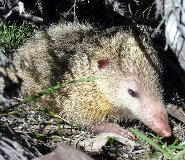
The
Tailless Tenrec (
Tenrec ecaudatus), also known as the Common Tenrec, is a species of mammal in the Tenrecidae family. The tenrec itself resembles a shrews or hedgehog. The tailless tenrec is most commonly found making its home in the islands near Madagascar, Mauritius, Réunion, and Seychelles. The natural habitat of the tailless tenrec is anywhere that is a little humid and warm. tailless tenrecs make there home in subtropical or tropical dry forests, lakesides, humid savanna, moist savanna, shrubland, high-altitude shrubland, subtropical or tropical lowlands and grassland, arable lands, domestic gardens, and urban areas. It is unique to the Madagascar and Indian Ocean area.
The Tailless Tenrec is also the largest of the land dwelling species that make up the many types of tenrec. At a typical length of 26 to 39 centimeters (10 to 15½ inches) in length and a weight of about 1.5 to 2.5 kg (3¼ to 5½ lb), the tailless tenrec is also one of the world's largest insectivores-- that is, an animal whose primary diet is insects. With its round, beady eyes and medium-length, soft gray to reddish-brown fur, it is also one of the most adorable insectivores. However, petting the tailless tenrec might not be a good idea, as it also has sharp spines along its body for protection. When it feels threatened, the tailless tenrec will shriek, make its spines puff up into a crest, jump out the way, and if it's cornered even buck and bite. While the tenrec mainly eats small insects hiding among leaves, it will occasionally eat any hiding frogs it its main food source is scarce enough.
The tailless tenrec will make a home out of nearby grass and leaves, sheltering its nest by building it underneath a rock, log or bush. It also has a large family-- the typical female tailless tenrec gives birth to a litter of about 15 to 20 babies at a time, though the highest recorded tenrec litter was 32 young. When the tailless tenrec is first born, they will usually have a fur coat that has black and white stripes, and may look almost mouse-like in appearance. The most curious fact of all is that despite being commonly known as the tailless tenrec, most tailless tenrec actually do have a tail! However, this tail is very small- only about 1 to 1.5 centimeters (⅜ to ½ inches) in length.
Picture of the tailless tencrec by Markus Fink, licensed under
GFDL
You can help spreading the word about this animal by liking it on facebook
Permanent Link
Monday 22 October 2012
The Eastern Spadefoot, the Toad Wielding a Shovel
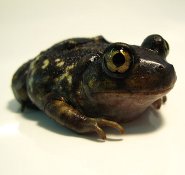
The
Eastern Spadefoot (
Scaphiopus holbrookii) is a burrowing toad found east of the Mississippi river. From the southern part of New England to the Florida Keys and as far west as Louisiana, these frogs can be found in forested lowlands with sandy or loose soil. They are commonly found on the banks of rivers prone to flooding, but seem to be absent form the higher altitudes of the Appalachians and the Everglades.
To blend in with the leafy forest floor, the Eastern Spadefoot is usually olive green, brown, gray, or black in color. It is about two to three inches (42 - 72 mm) long with two yellowish lines, which are more prominent in the males, starting from behind the eyes and running down the back. The underside of the body is usually white or grayish in color.
Although they are considered toads, they lack certain toad-like qualities. Their eyes are large and bulging, and unlike other toads, the pupils are vertical instead of horizontal. Their softer bodies and smoother skin is unusual for a toad, and they lack the paratoid glands on each side of the head.
The long, sharp, sickle-shaped shade on each hind foot is responsible for the Eastern Spadefoot's common name. Since these toads spend most of their time underground, these spades are used to dig burrows.
Quite secretive, the Eastern Spadefoot will usually only emerge to feed or during mating season which usually lasts from March to September. They will come out their burrows at sundown during warm, heavy rains and begin their mating ritual in shallow, temporary pools created by flooding or rain. Eggs will be laid in these pools and hatch within a week. Tadpoles will then transform within a few weeks to a couple of months.
Although the Eastern Spadefoot, like most toads, is threatened by other toads and snakes, the toxin secreted by their skin usually protects them from predators. Since the eggs are laid in temporary pools, the tadpoles don't have to worry much about being eaten by fish, but there is still a threat of other frogs and toads looking for a snack.
Tadpoles usually feed on plankton, and the adult Eastern Spadefoot will feed on many insects, including beetles, flies, and crickets; the occasional meal of earthworms, or small vertebrates such as salamanders is not unheard of.
Due to people increasingly encroaching into wild, the Eastern Spadefoot is considered endangered in many areas. Pennsylvania, Connecticut, Ohio, Massachusetts, and New York are some of the states that have reported a decline in this elusive toad population.
Picture of the eastern spadefoot by Riechvaugen, licensed under
GFDL
You can help spreading the word about this animal by liking it on facebook
Permanent Link
Tuesday 16 October 2012
Chinese Pangolins - Shy, Peace-loving Creatures
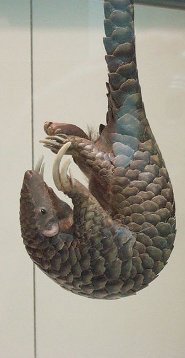
The
Chinese Pangolin (
Manis Pentadactyla) ranges eastward through India, Nepal, Burma, China, and eastern Himalayas. This species is mainly found in the deciduous forests and subtropical regions. The rolling hills of central Nepal have a huge number of termite mounds where Chinese pangolins are found in great numbers.
The Chinese Pangolin belongs to the burrowing family. It can dig up to 8 ft deep (2.5 meters) in the ground with its strong and clawed forefeet. It just takes the pangolin four to five minutes to dig that deep. Once it enters the burrow, it blocks the opening. Some Chinese pangolins occupy burrows of other animals as well.
The Chinese Pangolin appears like a scaly anteater. From head to body, it measures around 60 cm (24 inches) and its tail measures about 18 cm (7 inches). A mature Chinese pangolin weighs about 2.4 kg (82.72 oz). A new born baby pangolin weighs about 93 gram (3.26 oz). It has 18 rows of overlapping scales accompanied with hair, a rare combination found in mammals. It has a small narrow mouth and a little pointed head. Its nose is plump with nostrils at its end. This is a bronze colored animal with a round body equipped with extremely sharp claws.
The Chinese pangolin found in Nepal reproduces in the months of April and May when the weather is a bit warm. The female gives birth to a single young one at a time and the baby weighs about 1 lb (400 gm) and its length is about 45 cm (18 inches). The young one also has scales which remain very soft for two days. Although the young pangolin can walk on its very first day, the mother carries the baby on its back or tail. In case the mother feels threatened, it immediately folds her baby with its stomach with the help of its tail. Male pangolins have been noticed to show extraordinary parental instinct and allow the female and its baby share the burrow.
The Chinese pangolin is a rather secretive animal. They are considered nocturnal creatures and are extremely shy. They move very slowly and are known for their non-aggressive behavior. Their hard scales work as a protection cover from predators and when they feel endangered, they curl themselves in a ball. Chinese pangolins are mainly terrestrial animals and are observed in forests that are about 20 feet high from the ground.
They mainly eat insects as termites and ants. Their sharp claws help them in digging up the ants and termite mounds and with the help of their sticky, long tongue (25 cm), they can draw their prey into their mouth.
In Vietnam and Hong Kong, Chinese pangolins are considered a delicacy and they are hunted on a large scale only for this purpose. Now, Chinese pangolins are being protected in the forests where they are generally found. Factors like habitat destruction and hunting constantly challenges their survival. Since the forests they inhabit are difficult to patrol, hunters get a greater chance to hunt these animals without being caught.
Picture of the chinese pangolin by
verdammelt, licensed under the
Creative Commons Attribution-Share Alike 2.0 Generic license
You can help spreading the word about this animal by liking it on facebook
Permanent Link
Friday 12 October 2012
Gambian Pouched Rat - An Unlikely Hero
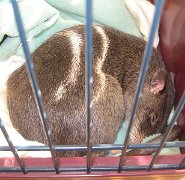
The
Gambian pouched rat (
Cricetomys gambianus) is truly one of the unsung heroes of the rodent world. Found wild throughout Africa; Gambian pouched rats weigh on average between 1 and 1.4 kilograms (2.2 and 3.1 lb). The length of this rodent can reach sizes of 64 to 91 cm (25.39 to 35.83 in) and beyond, including the tail. from nose to tail. The Gambian pouched rat is brown or gray and may have white or lighter colored markings on its feet and belly. It is called a pouched rat because it has large storage pouches in its cheeks, much like a hamster. Omnivorous by nature, captive Gambian pouched rats thrive on a diet of vegetables, seeds, and grains in addition to commercial rodent kibble. In their native habitat of forests and thickets, Gambian pouched rats feed on palm kernels, insects, crabs, and snails. They are a nocturnal animal with keen hearing and smell but poor eyesight. In Africa, they are considered “bushmeat” and commonly captured and eaten. The species is quite common on the African continent and is not endangered.
In the United States, the Gambian pouched rat is kept as a pet, although it is no longer legal to import specimens. Populations of Gambian pouched rats have become a problem in the Florida Keys where they have gained a toehold in the wild. Although it is not known precisely how the rat was released to the wild, it is most likely the result of careless pet owners allowing individuals to escape or deliberately releasing them when they became too hard to handle. Conservationists are concerned that the non-native species could have a serious negative impact on wildlife, particularly birds, as well as pose an agricultural threat if they should move to the mainland. Gambian pouched rats are believed to be one of the species that carry monkeypox and the recent outbreak of the disease in the United States is blamed on rats imported for the pet industry.
In 1996, Bart Weetjens began to experiment with Gambian pouched rats in detecting land mines. Weetjens sought a low-tech method of dealing with the problem of land mines and drew on his childhood experiences with pet rats. Gambian pouched rats have keen sense of smell and can be very docile if they are handled from a young age. Weetjens collaborated with the Belgium Directorate for International Cooperation and established APOPO, a nonprofit organization that trains mine detecting rats in Tanzania. Known as HeroRATS, Gambian pouched rats are trained to smell out explosives. When the rat scratches a patch of ground containing a land mine, a clicker is pressed and the animal receives a food reward.
Gambian pouched rats are also used to detect tuberculosis. Laboratory rats identify sputum samples infected with tuberculosis in a similar manner to rats trained to identify land mines. One rat can work its way through as many as 150 sputum samples in 30 minutes. Tuberculosis is a major health concern in Africa and early detection of the disease is crucial to successful treatment. Gambian pouched rats have been an economical and effective tool in fighting the spread of this disease.
Picture by
Liftarn, licensed under the
Creative Commons Attribution-Share Alike 3.0 Unported license
You can help spreading the word about this animal by liking it on facebook
Permanent Link
Tuesday 09 October 2012
Brown rat - The Smartest Garbage Disposal on Earth
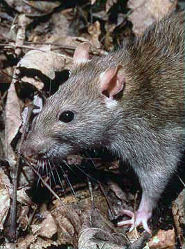
The
Brown rat (Rattus norvegicus) is an interesting creature for a number of reasons. Averaging at 18 cm in length, or 7 inches, and with an average weight of 300 grams, or 10.5 ounces, the brown rat has nevertheless managed to spread itself to most parts of the world. With the exclusion of the polar regions, the Canadian province of Alberta, and special areas of New Zealand, the Brown rat has essentially tied its migratory patterns to large concentrations of humans. Why so interested in humans? The answer is simple: one man's trash is another rat's treasure.
The origin of the brown rat is debatable, but as their scientific name implies, the original theory was that they spread from Norway into the rest of Europe, and from there the rest of the known world. Even today the exact origins of the brown rat are not known, although it is generally accepted to have originated somewhere in Asia, and then spread via English trading ships. The reason for the ease with which it spread lies in its diet; the brown rat will eat practically anything.
The brown rats love of starch and protein rich foods has left it with a love of cereal specifically, but it is not above adapting to the environment it inhabits. The brown rats are foragers, which means they will scour any remains for food, including any trash left in the open by humans. This is what keeps these two species inextricably linked. While its status as a forager might give the impression of an unintelligent animal, the truth is actually quite the opposite.
Recent research has found evidence to suggest that brown rats are one of the few creatures on Earth, besides humans and certain
primates, to possess the ability to essentially think about thinking. Coupling this with the social hierarchy they form within their own clans, with each rat assigned a specific role, and it's easy to see the links between these "simple" foragers and their "civilized" human counterparts.
While the brown rat does have predators in such creatures as cats, foxes, dogs, and owls, their high reproductive rate and general survival skills keep them on the opposite end of the endangered species spectrum. Pest control actually dedicates much of its time and resources to wiping out large concentrations of brown rats in human settlements, but their adaptive strategies and low standards for food quality make them a difficult creature to deal with efficiently. Truly, the brown rat is the smartest garbage disposal on Earth.
You can help spreading the word about this animal by liking it on facebook
Permanent Link
Friday 05 October 2012
Vampire bats - Nature's little bloodsuckers
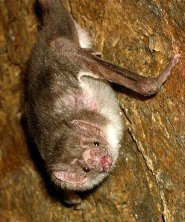
Vampire bats are in the subfamily Desmondontinae, as there are three different species alive today; they are the
Common Vampire bat (Desmodus rotundus), the Hairy-legged Vampire Bat (Diphylla ecaudata), and finally the White-winged Vampire Bat (Diaemus youngi). Each species has their own unique differences but are closely related, as they all are able to metabolize and break down blood (the eating of blood is called hematophagy), and they also have adaptations like thermoreceptors on their noses so that they can find mammals to feed on. Contrary to popular belief, they do not have venom nor are they specifically man hunters, but instead prefer the blood of large mammals like livestock. That is not to say that they do not occasionally use human blood, but they do not have fangs to suck blood out with. Instead they create a wound, and their saliva has an anti-coagulation property which allows the blood to flow freely, enabling them to lap it up into their stomachs or suck it up with specialized groves in their mouths on their tongues. They also do not make high pitch screams, but rather low pitch vocalizations which they use to communicate, and this is similar to the distantly related Fruit Bat (megabats) which also uses low pitch sound rather than high pitches.
The Hairy-legged vampire bat is a small bat that is around the same size as the Common Vampire Bat. It is adapted to mainly feed upon avian blood, rather than mammalian blood, and it is found in South America, and can be found resting with fellow bats. Usually found in small numbers, there have been larger colonies reported, but none bigger than 35 and can also be found co-habitating caves with the Common Vampire Bat. Within this species there are two regionally separated subspecies, one being the Diphylla ecaudata centralis which is in Mexico down to Panama, and Diphylla ecaudata ecaudata, which is found from Peru to Brazil and also eastern Panama.
The Common Vampire Bat (Desmodus rotundus) has a burnt amber fur on their backs while also a lighter brown on their bellies and measure around three and a half inches long (9 centimeters) and posses a wingspan of roughly a half foot or more - upward of seven inches (18 centimeters). They're very light (a whopping 2 ounces [57 grams]). This species has an advantage of a groove in their mouth which allows for sucking like a straw down the middle of the tongue, which is not present in the Hairy-legged vampire bat.
The White-winged Vampire Bat (Diaemus youngi) can sometimes be found in the same places as the Common Vampire Bat, and are known to feed on birds, rather than large mammals. They get their name from the white tips of their wings, while their color is close to that of the Common Vampire Bat if not a tad lighter and in the blond range. This species of bat does not jump on takeoff like the Common Vampire, nor does it hop around or run like the Vampire. However it possesses a unique advantage in that within its mouth is a pair of specialized glands that will emit a hissing, or putrid liquid and create a strongly offensive smell, possibly for defensive means. It is likely because of this defensive mechanism that they are more docile than the Common Vampire bat and easier to handle – they are also more vocal.
All three species of bat are located in the Desmodontinae Subfamily of the Family Phyllostomidae, which are all of the New World bats with leaf-nosed appearances. This Family is a part of the Suborder Microchiroptera, which are the microbats. However recent genetic studies may change the way bats are ordered, and furthermore change the order of the orders and suborders – however the currently recognized standard will be used for this. Microchiroptera belongs to the order Chiroptera, of which all bats are members. This order belongs to the Superorder Laurasiatheria, of which the hedgehogs, shrews, whales, anteaters, carnivores, and ungulates are a part of. Laurasiatheria in turn belongs to Eutheria, or all the placental mammals and their extinct ancestors – of which we are of course a member. In turn Eutheria belongs to the Subclass Theria of which all mammals except for the monotremes are members, and all mammals belong to the class Mammalia.
The behavior of Vampire Bats is to be communal and supportive, where if one bat fails to feed, another bat will share its food with it and increase the overall survival chances of the small colonies. They can often be found cohabitating but there is no interbreeding. They are all capable of remembering past meals and often revisit livestock that they have marked, as most of the time the livestock travels very little distance. Their numbers have been increasing, as before mankind began having larger land mammals they mostly fed on what could be found, from opossums to snakes and new world monkeys, and especially birds.
Interesting Facts about the Vampire Bats
- Vampire bats can double their weight in one feeding.
- Vampire bats will share blood if a member comes back without feeding, but that member is expected to do the same if it happens to another bat.
- Vampire bats, like all bats, have the possibility of spreading rabies, however only .5% of bats carry rabies. Those that do are likely unable to fly, and may act aggressive.
- Saliva (spit) from Vampire bats may be useful in treating stroke patients.
Picture of the Desmodus rotundus, Picture taken at Sangayan Island, Paracas National Reserve, Departamento Ica, Peru, in March 2005. Licensed under
GFDL
You can help spreading the word about this animal by liking it on facebook
Permanent Link
 The Tailless Tenrec (Tenrec ecaudatus), also known as the Common Tenrec, is a species of mammal in the Tenrecidae family. The tenrec itself resembles a shrews or hedgehog. The tailless tenrec is most commonly found making its home in the islands near Madagascar, Mauritius, Réunion, and Seychelles. The natural habitat of the tailless tenrec is anywhere that is a little humid and warm. tailless tenrecs make there home in subtropical or tropical dry forests, lakesides, humid savanna, moist savanna, shrubland, high-altitude shrubland, subtropical or tropical lowlands and grassland, arable lands, domestic gardens, and urban areas. It is unique to the Madagascar and Indian Ocean area.
The Tailless Tenrec (Tenrec ecaudatus), also known as the Common Tenrec, is a species of mammal in the Tenrecidae family. The tenrec itself resembles a shrews or hedgehog. The tailless tenrec is most commonly found making its home in the islands near Madagascar, Mauritius, Réunion, and Seychelles. The natural habitat of the tailless tenrec is anywhere that is a little humid and warm. tailless tenrecs make there home in subtropical or tropical dry forests, lakesides, humid savanna, moist savanna, shrubland, high-altitude shrubland, subtropical or tropical lowlands and grassland, arable lands, domestic gardens, and urban areas. It is unique to the Madagascar and Indian Ocean area.
 The
The  The
The  The
The  The
The  Vampire bats are in the subfamily Desmondontinae, as there are three different species alive today; they are the
Vampire bats are in the subfamily Desmondontinae, as there are three different species alive today; they are the